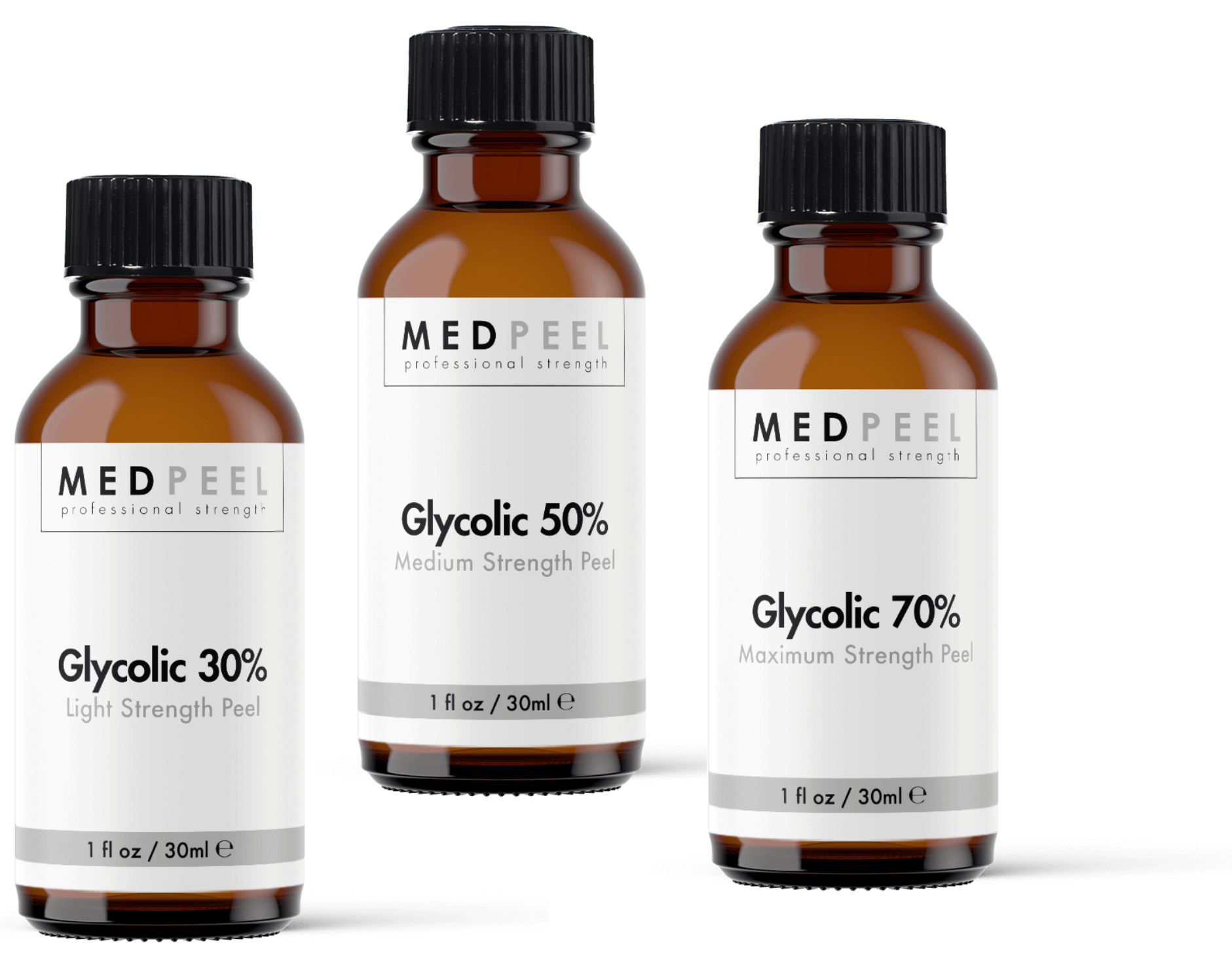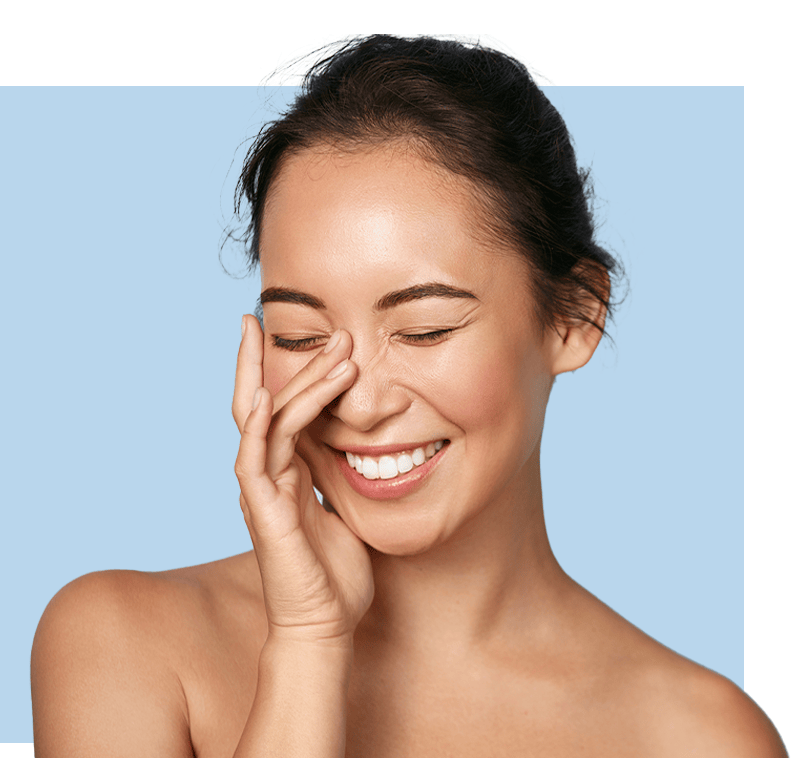




Glycolic acid is one of the most commonly known ingredients in skincare. It is a type of alpha-hydroxy acid (AHA) naturally found in various fruits, including sugarcane, grapes and citrus. It is often used in skincare products due to its natural exfoliating and skin-renewing properties. The small molecular size of AHAs, like glycolic acid, enable it to deeply penetrate the skin and break down the bonds that hold dead skin cells together, allowing them to be sloughed off more easily and reveal fresher, brighter skin underneath.
Additionally, glycolic acid has been shown to stimulate collagen production in the skin which can help to improve skin firmness and reduce the appearance of fine lines and wrinkles. Glycolic acid targets some of the most common skin issues, such as clogged pores and blackheads, dull, dehydrated skin and visible signs of aging.
Chemical peels work by causing controlled damage to the outer layers of the skin, which triggers a healing response. When performing a glycolic peel, you may experience a mild to moderate burning or stinging sensation as the acid penetrates the skin. After the peel, the skin will likely be red, swollen, and tender. Over the next several days, the skin may begin to peel and flake off, revealing smoother, brighter, and more youthful-looking skin underneath.
Depending on the depth of the peel performed, the recovery time can range from a few days to a week or more. It is important to follow proper pre and post peel instructions and to avoid picking at any peeling or flaking skin that may occur. While peeling is a common side effect of chemical peels, it is not a definitive indicator of the peel's success. When evaluating the effectiveness of a chemical peel, look for an improvement in the skin's overall texture and tone.
Glycolic acid is generally safe for all skin tones and types, particularly those with normal or combination skin. Glycolic acid can be irritating to some individuals, especially those with sensitive skin. It is recommended to start with lower concentrations and gradually increase usage to allow the skin to acclimate. It's important to be patient and take a gradual approach when it comes to chemical peels. By first introducing your skin to mild, low strength peels and slowly working your way up to higher strengths, you are safely building up your skin's tolerance and minimizing the risk of adverse reactions.
It is also essential to use sunscreen when incorporating glycolic acid into your skincare routine, as it can increase the skin's sensitivity to the sun.
GLYCOLIC 30%
Typically suitable for beginners or individuals with sensitive or dry skin. Provides a mild exfoliation and is less likely to cause significant downtime or side effects. It can help improve skin texture, even out skin tone, and enhance overall radiance.
GLYCOLIC 50%
Recommended for those who have already undergone the 30% glycolic acid peel and tolerated it well. As the next step up from a glycolic 30%, the 50% strength offers a more significant exfoliation and can address moderate skin concerns, such as fine lines, mild hyperpigmentation, and acne scars. May cause some redness and temporary flaking, and is generally well-tolerated by individuals with normal or combination skin.
GLYCOLIC 70%
Recommended for experienced peel users ONLY. This strength is more aggressive and typically used for more advanced skincare concerns. Can effectively target deep wrinkles, stubborn hyperpigmentation, and acne scars. This peel may require a longer recovery period and may cause significant peeling, redness, and irritation. It is generally recommended for individuals with thicker or more resilient skin. Due to the increased risk of hyperpigmentation, extra precaution is required for medium to dark skintones.
The primary purpose of glycolic acid is to exfoliate the skin and promote skin renewal by dissolving the bonds between dead skin cells so that they can be gently sloughed off. By removing the outer layer of dead skin cells, glycolic acid stimulates the skin's natural process of cell turnover, leading to the growth of new, healther skin cells.
To acheive the best results from your peel, proper before and after peel care is required.
BEFORE YOUR PEEL.
Prep the skin for a week prior to peel application with a daily exfoliator such as our Glycolic 10% Daily Exfoliator. We strongly suggest conducting a patch test 3 days before applying the chemical peel to ensure no negative or unusul reactions occur. To perform a patch test, choose a small, inconspicuous area of skin, cleanse the area and apply a small amount of the chemical peel. Allow the product to sit on the patch test area for 24-48 hours. Afterwards, carefully examine the patch test area for any signs of irritation or discomfort. If you experience any negative reactions, such as severe redness or swelling, remove the product immediately and do not proceed with the application.
When you are ready to apply the peel, cleanse the skin with a mild face wash such as our Skin Balancing Cleansing Gel and apply the Peel Prep Solution to the area being treated. Peel Prep helps remove any last traces of oil, dirt and impurities from the skin to ensure a more effective and even penetration of the chemical peel.
AFTER YOUR PEEL
After the recommended time for peel application has passed, use the Neutralizer Solution Spray to help safely balance the pH of the skin and stop the exfoliation process. Keep the skin hydrated with a hyaluronic serum such as our Hydra-Plump Hyaluronic Serum 2.5% and protected with a broad-spectrum sunscreen of at least SPF 30 daily. Refrain from touching, scratching, or picking at the treated area. You may use our Glycolic 10% Daily Exfoliator to gently buff away any peeling or flaking skin. Maintain a consistent skincare routine of cleansing, exfoilating and moisturizing to prolong the benefits of your chemical peel.
GLYCOLIC 30% - LIGHT STRENGTH
Downtime is typically minimal, if any. You may experience some redness, slight tingling, or mild flaking, which can last for a few hours up to a day.
GLYCOLIC 50% - MEDIUM STRENGTH
May require a short downtime of a few days. You may experience more noticeable redness, flaking, and peeling.
GLYCOLIC 70% - DEEP STRENGTH
May have a more significant downtime of up to a week or more. The skin may experience substantial redness, peeling, and flaking.


